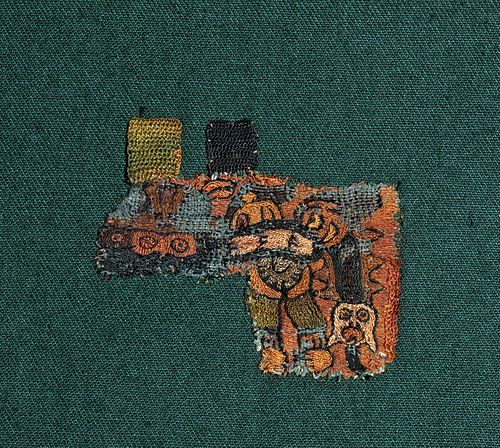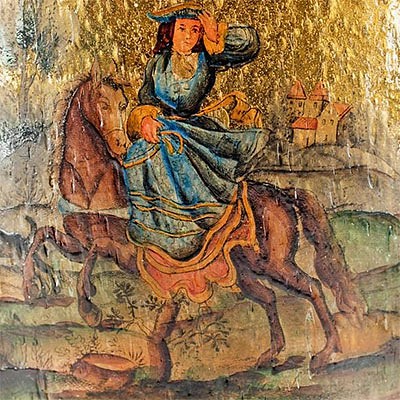Paracas Textile Fragment - Warrior w/ Trophy Heads
Lot 88
About Seller
Artemis Fine Arts
686 S Taylor Ave, Ste 106
Louisville, CO 80027
United States
Selling antiquities, ancient and ethnographic art online since 1993, Artemis Gallery specializes in Classical Antiquities (Egyptian, Greek, Roman, Near Eastern), Asian, Pre-Columbian, African / Tribal / Oceanographic art. Our extensive inventory includes pottery, stone, metal, wood, glass and textil...Read more
Categories
Estimate:
$1,500 - $2,000
Absentee vs Live bid
Two ways to bid:
- Leave a max absentee bid and the platform will bid on your behalf up to your maximum bid during the live auction.
- Bid live during the auction and your bids will be submitted real-time to the auctioneer.
Bid Increments
| Price | Bid Increment |
|---|---|
| $0 | $25 |
| $300 | $50 |
| $1,000 | $100 |
| $2,000 | $250 |
| $5,000 | $500 |
| $10,000 | $1,000 |
| $20,000 | $2,500 |
| $50,000 | $5,000 |
| $100,000 | $10,000 |
| $200,000 | $20,000 |
About Auction
By Artemis Fine Arts
May 13, 2021
Set Reminder
2021-05-13 12:00:00
2021-05-13 12:00:00
America/New_York
Bidsquare
Bidsquare : Spring Art Auction | Fine, Folk, Fun
https://www.bidsquare.com/auctions/artemis-gallery/spring-art-auction-fine-folk-fun-6949
Featuring visual treats from around the world, and back in time to present day - fine art, folk art, and fun artsy objects. Paintings. Sculptures. Textiles. More. Convenient in-house shipping. Artemis Fine Arts info@artemisfinearts.com
Featuring visual treats from around the world, and back in time to present day - fine art, folk art, and fun artsy objects. Paintings. Sculptures. Textiles. More. Convenient in-house shipping. Artemis Fine Arts info@artemisfinearts.com
- Lot Description
Pre-Columbian, South Coast Peru, Paracas culture, ca. 500 to 300 BCE. A petite textile fragment composed of tightly woven camelid (alpaca or llama wool) fibers in hues of orange, brown, blue, green, cream, sage, and fuchsia. The textile fragment depicts a highly stylized flying warrior figure wearing a loincloth between delineated legs as well as a belt bearing three disembodied trophy heads. The face of the warrior presents with red eyes atop an orange stripe and wears a brown headdress with three projecting tabs. Mounted atop a museum-quality display fabric. Size (textile): 2.75" L x 1.75" W (7 cm x 4.4 cm); (display fabric): 17" L x 14.5" W (43.2 cm x 36.8 cm).
Little is known about the Paracas people, and what little we do know comes from a 1920s archaeological excavation of the Paracas Cavernas, shaft tombs containing multiple burials, many of which contained ceramic vessels, probably for holding offerings or provisioning the dead in the afterlife. The iconography of the Paracas people is linear and stylistic, based on formal figures whose species, when zoomorphic, often cannot be identified. Motifs on their textiles mirror those of their ceramics that they used to wrap their dead and probably represent gods or mythical figures of power.
Provenance: private Hawaii, USA collection; ex-Arte Primitivo Gallery, New York, New York, USA
All items legal to buy/sell under U.S. Statute covering cultural patrimony Code 2600, CHAPTER 14, and are guaranteed to be as described or your money back.
A Certificate of Authenticity will accompany all winning bids.
We ship worldwide and handle all shipping in-house for your convenience.
#148268This is a fragment of a larger textile composition. Losses to peripheral threads as shown. Loosening and fraying to some interior and peripheral threads, with light fading to original coloration. Iconography is still visible.Condition
- Shipping Info
-
All shipping is handled in-house for your convenience. Your invoice from Artemis Gallery will include shipping calculation instructions. If in doubt, please inquire BEFORE bidding for estimated shipping costs for individual items.
-
- Buyer's Premium



 EUR
EUR CAD
CAD AUD
AUD GBP
GBP MXN
MXN HKD
HKD CNY
CNY MYR
MYR SEK
SEK SGD
SGD CHF
CHF THB
THB












